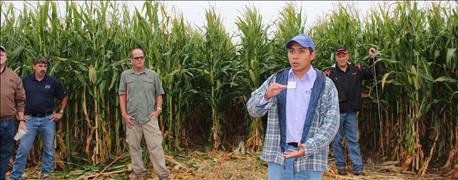
Some years are better than others when it comes to collecting water use research data.
"We had a lot more rainfall than we normally get, and that made it difficult to know how much impact was due to irrigation practices and what was due to plentiful rainfall," says Jonathan Aguilar, one of the water specialists at Kansas State University who conducted research on three water technology farms during the 2016 growing season.
On the Dwane Roth farm near Garden City, researchers compared mobile drip irrigation with iWob and bubbler systems.

FIELD DAY: Researcher Jonathan Aguilar, foreground, explains irrigation technology experiments during a field day at the Dwane Roth farm west of Garden City. Photo courtesy of Kansas State University Research and Extension.
"We were hoping to see some yield difference that we could attribute to the method of irrigation," Aguilar says. "We really didn't see that this year, and one potential reason is that the farm had 25 inches of rain this year. We will be repeating the research in 2017, and if we have our normal rainfall, or less, we could see bigger differences."
The Garden City Co-op provided soil moisture probes for the field, and all three systems were mounted in three irrigation spans on a center pivot equipped with remote control capability.
"We irrigated according to field need when the soil probe indicated the crop needed water," Aguilar says.
The Roth cornfield harvest was 228 bushels per acre with rainfall of 215.2 inches and 11.1 inches of irrigation water.
The idea for the Water Technology Farm project came from conversations at the 2015 Governor's Water Conference about the possibility of establishing a demonstration farm to take a look at different kinds of irrigation technology on a farm-sized scale.

"When farmers can see how this is applied on the level of a full circle, not just a few rows of a demonstration plot, it means a lot more to them," Aguilar says. "This tests how the technology works over an entire field."
By planting time in the spring of 2016, researchers had three farmer-partners and a consortium of public and private business partners to equip three water technology farms: Tom Willis' T&O Farm south of Garden City, the Roth-Garden City Co. Farm west of Garden City and the Waterpack/ILS Farm south of Larned.
Field days were held during the growing season at all three fields, enabling area farmers to see how the various technologies worked.
"We were able to generate a lot of conversation, more awareness of conservation options and more interest in water conservation areas," he says.
Researchers did find that clearly and consistently, the use of moisture probes does reduce the amount of irrigation needed.
"At all three farms, we found that the probes provided the farmers with much more confidence about turning the pivot off," Aguilar says. "Roth said the sensors enabled him to turn the pivot off and still sleep at night."

FULL SPAN: Three irrigation methods were deployed on a single pivot at the Dwane Roth farm west of Garden City: bubbler, iWob and mobile drip line. Researchers hoped to see yield increases with more efficient irrigation technology, but in the first year of study, all yields were about the same. Photo courtesy of Kansas State University Research and Extension.
Each of the three farms involved in the Water Technology Farm project either has formed or is in the process of forming its own Water Conservation Area, a new tool from the Kansas Division of Water Resources that allows farmers to voluntarily reduce the amount of water they use.
Water conservation areas can be formed by individuals or groups of people on a small, more personalized scale than local enhanced management areas, which were approved for voluntary reduced use.
The state has only one LEMA, the Sheridan Six in northwest Kansas.
The Sheridan Six has been very effective at reducing water use by 20% over a five-year period while maintaining yield, says Mitch Baalman, one of the participants. Baalman says he harvested 230-bushel corn and 60-bushel soybeans on his farm this year, while using the least irrigation he has used in years.
Brownie Wilson with the Kansas Geological Survey says the water table in the Sheridan Six area should see the first rise in level in five decades.
Aguilar says the work at each of the water technology farms will continue in 2017 and perhaps beyond.
"Our goal is to help famers make the decisions and implement the technology that will work best on their farm while also reducing water consumption," he says.
Next issue: Results from Waterpack/ILS Water Technology Farm.
About the Author(s)
You May Also Like




